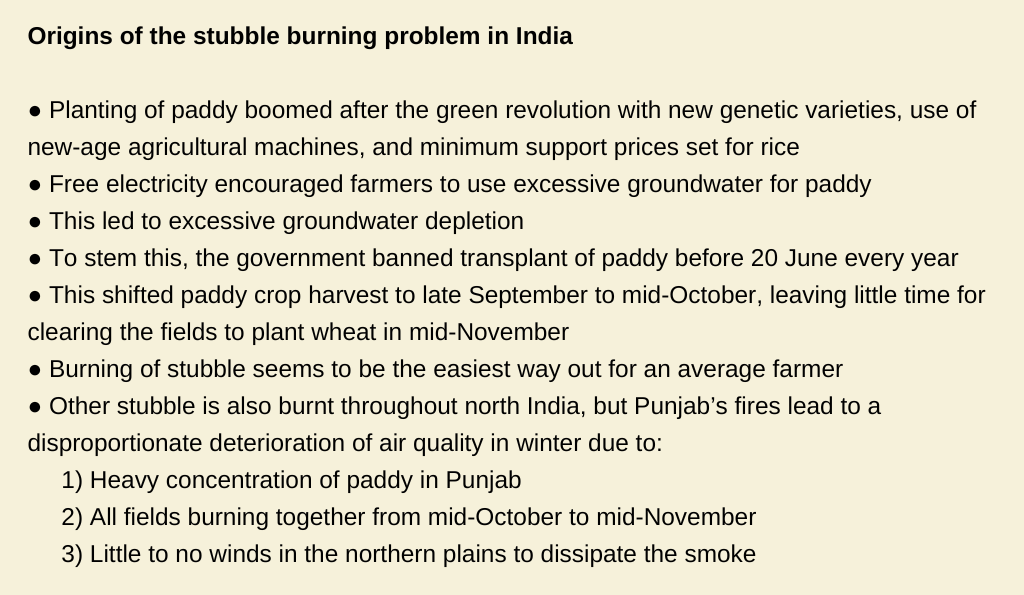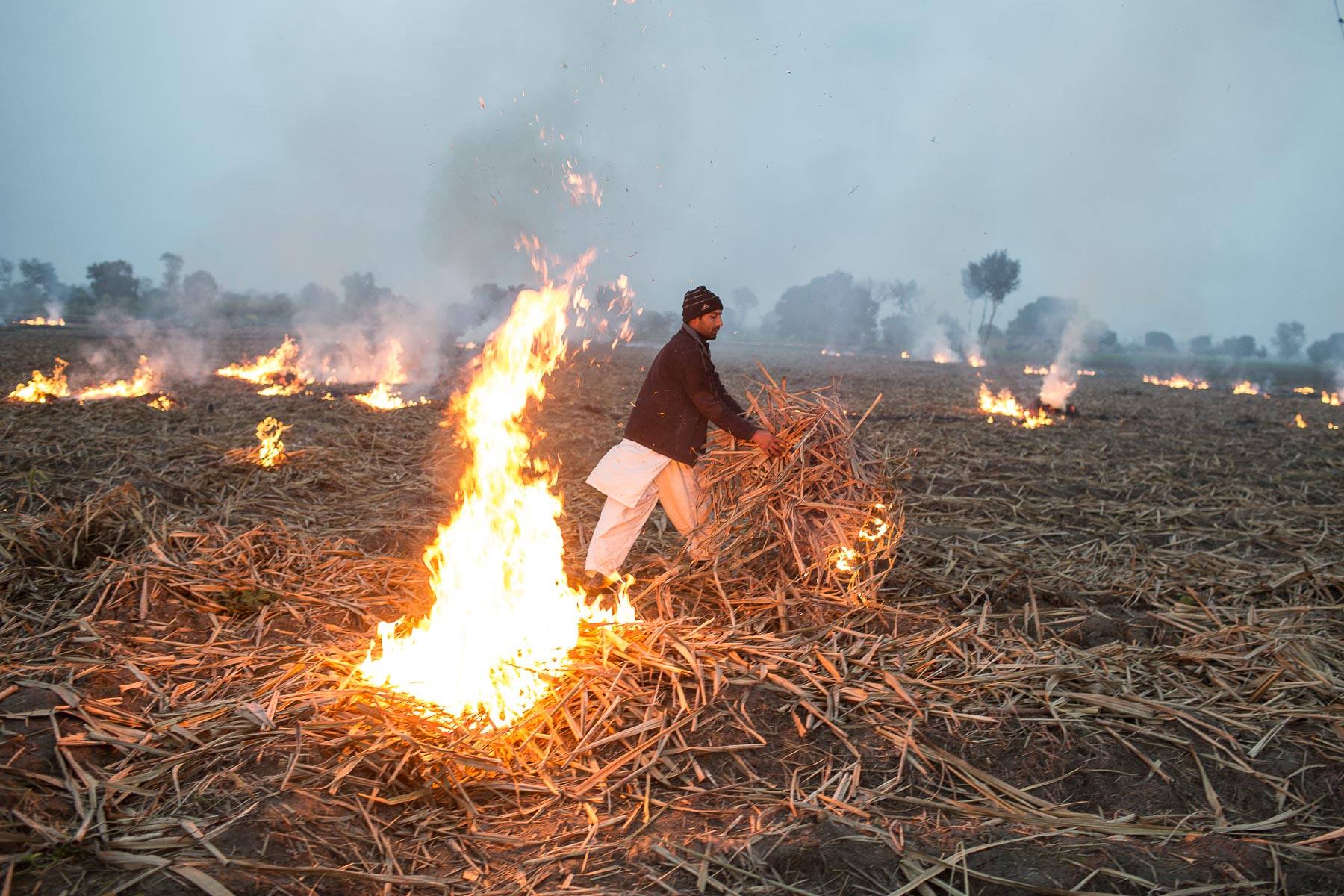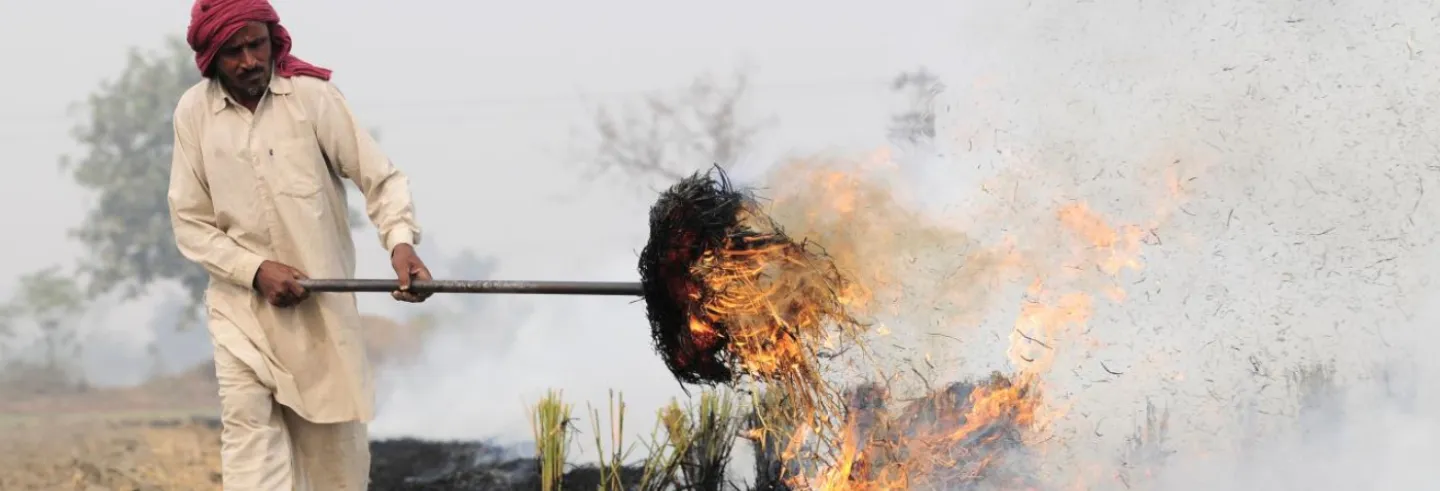It is only March, but the sun is already blinding and the air shimmers with heat. Muradpura, in Indian Punjab’s Amritsar district, is barely 40 km from the India-Pakistan border. Mangal Singh owns around 1 qilla (approximately 1 acre) of land here. As he looks contemplatively at fields of brilliant green wheat, he explains what will happen next.
In a few weeks, the sheaves will turn gold. After harvesting the crop, he says, he will leave the fields fallow for a few days.
Then he will sprinkle kerosene over his land and set it on fire.
After the flames rise and consume the fields, evoking horrifying images from the recent history of the two provinces that were one till 1947, all that will remain is charred stumps of the crop. The smoke will rise and travel towards Amritsar and beyond. At this time of the year, the April heat and the wind will help it disperse.
In November, he will go through the same exercise again. Then, though, the smog will travel through Amritsar to other north Indian cities like Delhi and settle there for weeks, causing an alarming rise in lung diseases. Those who can will leave Delhi. Many will buy air purifiers. But most will cough, sneeze, wheeze and live with laboured breathing until the smog disperses.
It is the same story in Pakistan.
The first time the smog phenomenon hit Lahore, Pakistan’s second-largest city, was in 2016. Since then, the pollution has been getting progressively worse. In the winter months, Lahore has repeatedly topped the daily rankings of the most polluted city in the world. From October to December, this city of 12 million barely sees sunlight as a thick cloud of polluted matter remains suspended above. Punjab, of which Lahore is the capital, is the most populous province in Pakistan with an estimated population of 110 million. Five cities in Punjab have been listed among the 50 most polluted cities in the world during the winter months since 2020.
Says Akshat Patni, environment policy expert and adviser to the government of the Indian state of Punjab, “In 2019, 50,000 deaths in Punjab alone were attributed to air pollution. This would not have been the case earlier: the cause would have been lung cancer or something else. This is a useful stat because it helps identify the problem and begin searching for a solution.”
The burning of agricultural waste takes place on both sides of the border. Incinerating stubble left over after harvesting the previous crop is the cheapest way of readying fields for another crop. But the burning intensifies particulate matter in the air. Over the years, both countries have been trying to find ways to mitigate the problem.

Ishaq Khakwani, an agriculturist in Pakistan, says that stubble burning is usually carried out when the rice crop stubble is removed in October to make way for the new wheat crop which is sown in November. “The time period is short and burning the stubble is the cheapest and quickest way to clear the soil,” he says.

The same practice is carried out in March when the crop is sown and the fields are cleared beforehand. But pollution at that time is lower because the weather is conducive to the heat, dust and smoke travelling upwards. Khakwani argues that crop burning, while a contributor, is only one factor and “one that hasn’t increased as well, so the problem lies elsewhere.”
Most experts agree that there is no cheap way to clear crop stubble and the government will have to intervene. In India, for example, the government gives a subsidy to farmers not to burn their crop stubble.
“There is no incentive to stop crop burning,” says Dawar Butt, an environmental consultant, about Pakistan. Butt says that the smog is a trans-boundary issue in which both Pakistan and India have to cooperate. India, he says, ends up suffering more as with the direction of winds on most days, it is pollution from Pakistan that drifts into India.
“We know that our burning stubble (parali) affects the environment. We want our children to grow up healthy. We don’t want to hurt anyone’s health. But we are helpless. Farming cannot make anyone rich. And if we spend money on cutting parali and packing it as the government is asking us to do, we will have no income” says Harpal Singh, from Muradpura, India.
“Just as you have come, the government comes to meet us, comes to gurudwaras. ‘Come, we’ll tell you how to do it’ they tell us, with kindness. Then they take our pictures, just as you are doing, and go away. No one cares whether we have burnt our fields, whether we’ve got compensation […] we contract farmland at Rs 60,000 an acre. We have to pay for inputs, tractors, threshing machines […] the income is very low. If from that we also have to make arrangements to dispose of parali (stubble), well, farming would then earn us no income at all.” he says.
The repercussions are alarming on both sides of the border. The 2023 Air Quality Life Index, carried out by the Energy Policy Institute at the University of Chicago, found that air pollution shortens lives by an average of 11.9 years in New Delhi and 7.5 years in Lahore. Nonprofit Fair Finance Pakistan has estimated that air pollution leads to at least 128,000 deaths every year in the country. In India, pollution has led to more than 1.6 million premature deaths, according to a 2019 study by The Lancet.
Stubble burning not the only reason
Alarming as all this may sound, stubble burning is not the only reason for the rising air pollution in both India and Pakistan.
Unpredictable weather patterns have led to a rise in smog levels even during summer months. Climate change has been exacerbated by the rapid cutting down of trees and the uprooting of farms around Lahore to make way for the development of commercial and residential colonies. With the completion of the Lahore Ring Road, an 85-kilometer orbital highway that circles the city, there are endless possibilities for urban development. But this has come at a cost. Farm produce has become costlier and rains are less predictable.
The health implications of pollution in Pakistan
In January 2024, pneumonia claimed 350 lives in Punjab province. Lahore was the epicenter where in just 7 days in January there were 55 deaths. Dr Amer Iqbal, one of Lahore’s leading pulmonologists accepts that the number of pneumonia cases has been increasing over the years but so far there has been no causal link established with the rising smog in the city during winter months. Pneumonia is caused by infection or by chemical inhalation. “But there is no investigation done or data collected on what caused the pneumonia in the first place,” says Iqbal. “Since the death is not a police case, there is also no autopsy done.” This opinion is backed by another leading medical practitioner of the city, Dr Shafqat Mahmood. He says, “We cannot come to a concrete conclusion without collecting data and conducting a full study.” But Dr Mahmood says that the initiatives taken by the government to reduce pollution have failed. He adds that pneumonia in children is more common because the lungs are more susceptible and the body is unable to filter pollutants as efficiently as adults can. Amongst the medical profession, there has not been enough discussion on why the cases have risen dramatically. Instead, doctors are content to blame several factors which include changes in weather, pollution, dry heating, living in small and closed rooms as well as poor nutrition and lack of awareness amongst children.

Research conducted over a 10-year-period on Lahore rainfall trends by Sarwat Shehzad, a senior subject specialist, shows a consistent and significant decrease in rainfall patterns in spring, summer and winter seasons whereas, simultaneously consistent increasing trends have been found in the rainfall data in autumn. This means droughts in three seasons and urban flooding in one.
Malik Tariq Ali, a long-term Lahore resident, comments that greed has overtaken all other considerations and that is why the problem is growing. “Greed, apathy and a lack of common sense,” he says adding that he has seen how over the past ten years the city, which was surrounded by green spaces, has given in to urban development. “Most of these areas are uninhibited but people keep on buying empty plots in the hope they will make windfall profits in the coming years.”
Land prices have risen over 200 % in the past five years. It is a much-happening industry. The real estate lobby in Pakistan is very resourceful and very powerful. “Much like the gun lobby in America. You cannot do anything against them.”
The apathy and state indifference can be seen in many areas, even when things can be set right. Take the case of vehicle pollution in the cities. Rafay Alam says the quality of fuel used in Pakistan is Euro 2 compliant, which is much lower than international standards and more polluting. Only one refinery in Pakistan produces fuel that meets Euro 4 standards. There is no plan to improve fuel quality, a major contributor to poor air quality in the cities.
The other problem is that in Pakistan while public transport and commercial vehicles have to pass a roadworthiness test, private cars and motorcycles do not. This means that most vehicles on the road are not even monitored for their exhaust emissions.
Dawar Butt, an environment consultant who has extensively worked on pollution-related issues in Pakistan lists many factors contributing to the smog: the number and quality of vehicles and fuel, industrial pollution, industrialisation in central Punjab, growing population as well as climate change. Butt notes that while rice stubble burning has remained constant, solid waste burning has increased significantly over the years.
This mess, says Butt, crosses over to Indian Punjab. “The wind direction moves from Central Asia to India. The westerly winds move from Pakistan into the Indian plains in the winters,” he says. The problem, he argues, affects both countries, regardless of who is to blame. “Will anyone in the leadership of Pakistan or India wake up and do something about it?”
While Rafay Alam and Dawar Butt cite examples of other cities like Beijing and Stockholm where public pressure pushed the government to act, the problem in Pakistan and India’s case is that it is two different governments that need to be convinced. Worse is the fact that these two don’t seem to agree on anything.
Says Patni, the Indian Punjab government adviser. “Stubble burning is like the cherry on the cake. There are a lot of factors that contribute to air pollution all year round. Stubble burning is about 8 per cent only. If you have to do a source apportionment of air pollution, it is vehicular pollution: nearly 50 to 52 per cent. If you go into a bit more depth, it is industries: stone crushing, brick kilns….and of course, road dust.” But he says stubble burning is intense during certain months and it adds to overall pollution levels, making the air unbreathable.
Avinash Chanchal, campaign manager with Greenpeace India says air pollution in India is the result of an amalgam of factors. “Stubble burning is an episodic contributor,” he says. Burning fossil fuel causes vehicular emissions. Coal-fired power plants add to this. The construction sector adds road dust. Households that burn biomass (wood and cow dung pats) also contribute.”
Sobering data
India is the world’s second most polluted country. Fine particulate air pollution (PM2.5) shortens an average Indian’s life expectancy by 5.3 years, relative to World Health Organization (WHO) guidelines. Some areas of India fare much worse than average, with air pollution shortening lives by 11.9 years in the National Capital Territory of Delhi, the most polluted city in the world.
Measured in terms of life expectancy, particulate pollution is the greatest threat to human health in India, taking 5.3 years off the life of an average Indian. In contrast, cardiovascular diseases reduce an average Indian’s life expectancy by about 4.5 years, while child and maternal malnutrition reduces life expectancy by 1.8 years.
Worsening situation
Particulate pollution has increased over time. From 1998 to 2021, average annual particulate pollution increased by 67.7 %, further reducing average life expectancy by 2.3 years. From 2013 to 2021, 59.1 % of the world’s increase in pollution was in India.
In the most polluted region of the country—the Northern Plains—521.2 million residents or 38.9 % of India’s population are on track to lose 8 years of life expectancy on average relative to the WHO guidelines and 4.5 years relative to the national standard if current pollution levels persist.
The University of Chicago’s Energy Policy Institute estimates that if India were to reduce particulate pollution to meet the WHO guidelines, residents in Delhi would gain 11.9 years of life expectancy. In West Bengal’s North 24 Parganas – the country’s second most populous district – residents would gain 5.6 years of life expectancy.
In 2019, India declared a “war against pollution” and launched its National Clean Air Programme (NCAP), signalling its desire to reduce particulate pollution. NCAP originally aimed to reduce particulate pollution by 20-30 % nationally relative to 2017 levels by 2024 and focused on 102 cities that were not meeting India’s national annual PM5 standard, termed “non-attainment cities.”
One of these was Delhi. The air pollution problem in the Delhi National Capital Region has a direct link to development. The broader metropolis is still the most attractive investment destination in north India. Delhi alone got USD28.3 billion in foreign equity inflows between October 2019 and September 2023, to rank fourth after Maharashtra, Karnataka and Gujarat. This excludes foreign equity invested in enterprises in Gurugram in Haryana.
There’s a cost to be paid for this level of inflows. Investment is linked to good road infrastructure, and seamless availability of power. Coal-based electricity constitutes 70 % of India’s power supply, and unsurprisingly, the cities with the lowest air quality index are located in the vicinity of coal-power thermal power plants, like Chandrapur in Maharashtra), and modern housing. All these activities load the air with pollutants.
Structural problems
There are also structural problems the two Punjabs face. “The inherent disadvantages specifically of the Indo-Gangetic plain stemming from its geographical location and soil composition compounds the air pollution woes for the region. The Indo-Gangetic plain is essentially landlocked and the Himalayas prevent polluted air from escaping to the north, creating the so-called ‘valley effect’ and dry alluvial soil significantly contributes to wind-blown dust,” the NCAP report says of north India.
Way forward
Bad air is a shared existential threat for Indians and Pakistanis. Conversations between India and Pakistan could result in shared knowledge and ways to mitigate the problem.
But Ashok Behuria of the Manohar Parrikar Institute of Defence Studies and Analyses, a government-funded research institution in India, says that despite having many of the same problems, India and Pakistan do not have any bilateral mechanism to deal with climate change issues. Both are signatories to the Paris Agreement of 2015, born out of the United Nations Climate Change Conference, which focussed on environmental changes and signified the commitments of the participating countries to find solutions for them.
“Both India and Pakistan, as primarily agrarian economies, do have a lot of stake in global efforts aimed at addressing climate change issues like increase in the level of greenhouse gases, erratic monsoons, extreme weather events like heat and cold waves, large storms including retreating glaciers in the Himalayas that supply meltwater to the river systems in both the countries. Given the long-term adverse impacts of such ecological changes on their economy and society, there is an argument that both countries should discuss these issues.
“However, no bilateral conversation on these issues has fructified primarily because of Pakistan’s emphasis on Kashmir as the core issue, and its disinclination to discuss any other issue save this, in clear disregard of the pre-existing consensus to discuss all issues together in a composite dialogue format,” Behuria says.
In 2017, then (Pakistan) Punjab Chief Minister Shahbaz Sharif wrote to Indian Punjab Chief Minister Amarinder Singh, suggesting a common approach to resolve the problem. Shahbaz expressed his belief, “that it is in the interest of the people of both Punjabs to make a collective effort towards identifying technologies and business methods that may eliminate the need to burn rice-stubble and help control smog formation.”
But for interlocutors on both sides of the border, the keyword here was not ‘health crisis.’ The keyword was ‘distrust.’
Between then and now, many citizens’ WhatsApp groups and NGOs meeting in third countries have considered ways to leverage technology to address the problem of air pollution. These have had limited impact.
So are India and Pakistan heading towards smog of the kind Beijing has in winter? Given the magnitude of the problem, there are no easy answers. The only thing that is clear is that solutions have to be found in both the countries and collectively for people to lead healthy lives before they reach a point of no return.
This essay was first published on Aaj and has also been published on Awaaz SouthAsia










